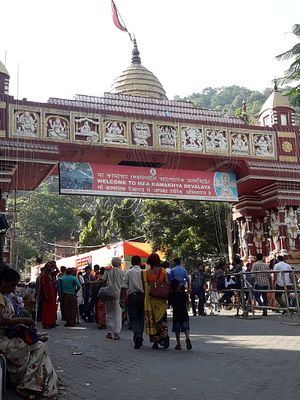More than 2 million people assembled at the Ambubachi Mela, which is one of the biggest religious festivals of eastern India in the border state of Assam. Celebrated in June every year at Kamakhya temple in Guwahati, the four-day festival coincides with the Hindu month of Asadha, during which the goddess is believed to go through the annual cycle of menstruation.
During the period of Ambubachi, the shrine remains closed and opens for devotees only on the last day of the festival, which is followed by elaborate rituals and a fair at the temple premises perched atop the scenic Nilachal Hills on the banks of the Brahmaputra River. Temples across the region remain shut for three days and agricultural work like digging, plowing, and sowing of crops are forbidden. The main attraction for the devotees is the divine “Prasad” consisting of small bits of red colored cloth supposedly moist with the menstrual fluid of the Goddess and considered to attract good luck and charm.
Kamakhya temple is one of the prominent 51 Saktipeeths spread across South Asia, with each representing a body part of Sati, Lord Shiva’s consort. The sanctum sanctorum at Kamakhypa houses the yoni or the female genital represented by a rock, considered one of the most important centers of Tantric worship. Some religious texts are of the view that the temple was demolished by Mughal general Kalapahar and was then rebuilt by King Naranarayana in the 16th century.
This year, the festival courted controversy when the headless body of a woman was found near the temple just three days ahead of the commencement of the event. Police officials were quoted by the media as saying that they suspected it to be a case of human sacrifice. The presence of an earthen lamp and a pot near the body, which was wrapped in a blanket, suggests that a religious ritual might have taken place.
Among the numerous Tantric cults in existence, some from the Kulacarya sect believe that offering sacrifices to the goddess would further their efforts at seeking enlightenment leading to moksha or liberation from the cycle of births and deaths. Several temples dedicated to different gods and goddesses are also found in the premises of Kamakhya where goats, buffaloes, and pigeons are sacrificed throughout the year by Tantric practitioners and devotees.











































